21 Best Small Or Dwarf Palm Trees For Your Landscape (With Pictures)
Looking to add a touch of tropical elegance to your landscape? Consider introducing one of the many magnificent small or dwarf palm trees available. These compact beauties come in a stunning array of shapes and sizes, making them perfect for adding a dash of exotic charm to even the smallest of outdoor spaces.
In this article, we’ll delve into the wonderful world of small palm trees, exploring not only their unique characteristics but also highlighting some of the most impressive varieties out there. With over 20 species to choose from, you’re sure to find the perfect addition to your garden or yard. So why wait? Let’s embark on a journey to discover the magic of these miniature marvels and how they can bring a touch of paradise to your own backyard!
Types Of Small Palm Trees
Adonidia Palm (Adonidia merrillii)
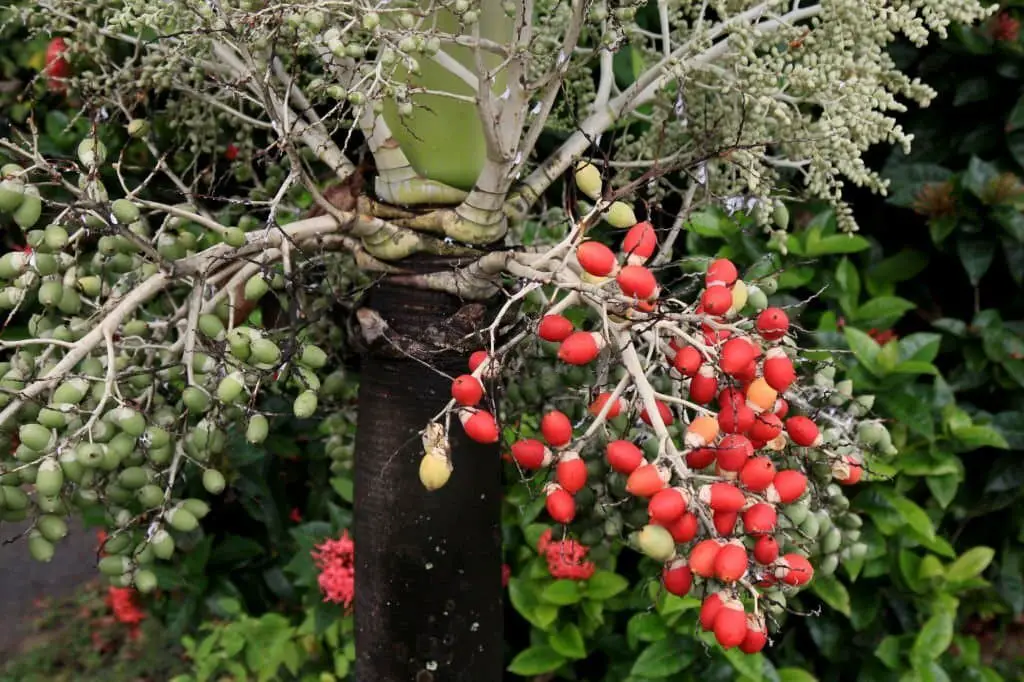
The Adonidia Palm, a versatile and compact palm, thrives in various landscapes. While it can grow up to 20 feet tall, its typical height is much smaller. Its slender trunk supports beautiful, deep green leaves that add a touch of elegance to any setting. Whether for a home or office landscape, this palm is an excellent choice.
Native to the Philippines and also known as the Christmas Palm, this evergreen tree earns its festive name from its vibrant red fruits that appear in December.
As an evergreen palm, it maintains its lush foliage throughout the year.
To flourish, the Adonidia Palm prefers full sun to partial shade and well-drained soil. Its drought tolerance and low maintenance requirements make it an ideal option for busy landscape owners.
Bottle Palm (Hyophorbe lagenicaulis).
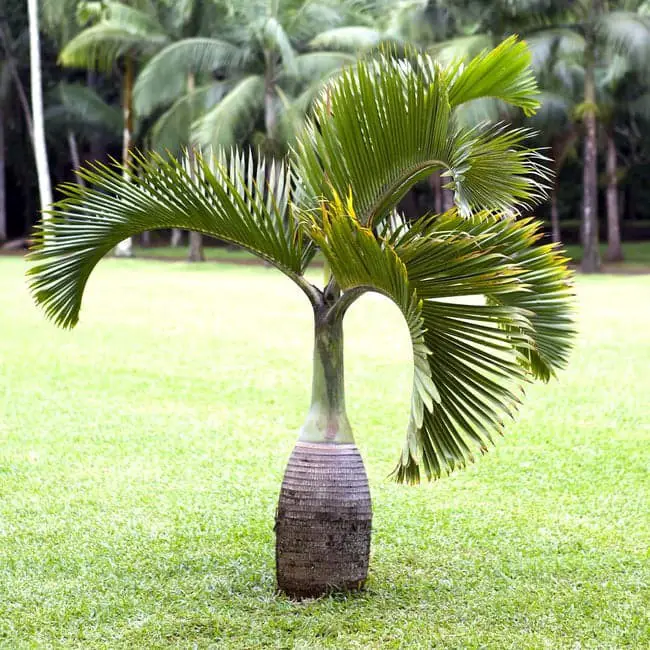
The Bottle Palm, originating from Mauritius and Reunion Island in the Indian Ocean, is a compact to medium-sized palm that reaches approximately 15 feet in height, with a slender trunk. Its unique feature is its swollen base, reminiscent of an antique bottle or genie lamp, hence its name. The leaves of this palm are around three feet long, featuring a pinnate structure with roughly 20 leaflets arranged in a V-shape and bearing serrated edges.
As slow growers, Bottle Palms may take several years to reach their full height. However, they’ve adapted well to challenging conditions; once established, they’re drought-tolerant and can withstand salt spray, making them an excellent choice for coastal gardens. They thrive in full sun but will also tolerate some shade. Additionally, this palm is surprisingly cold-hardy, capable of withstanding temperatures as low as 20 degrees Fahrenheit.
Cat Palm (Chamaedorea cataractarum).
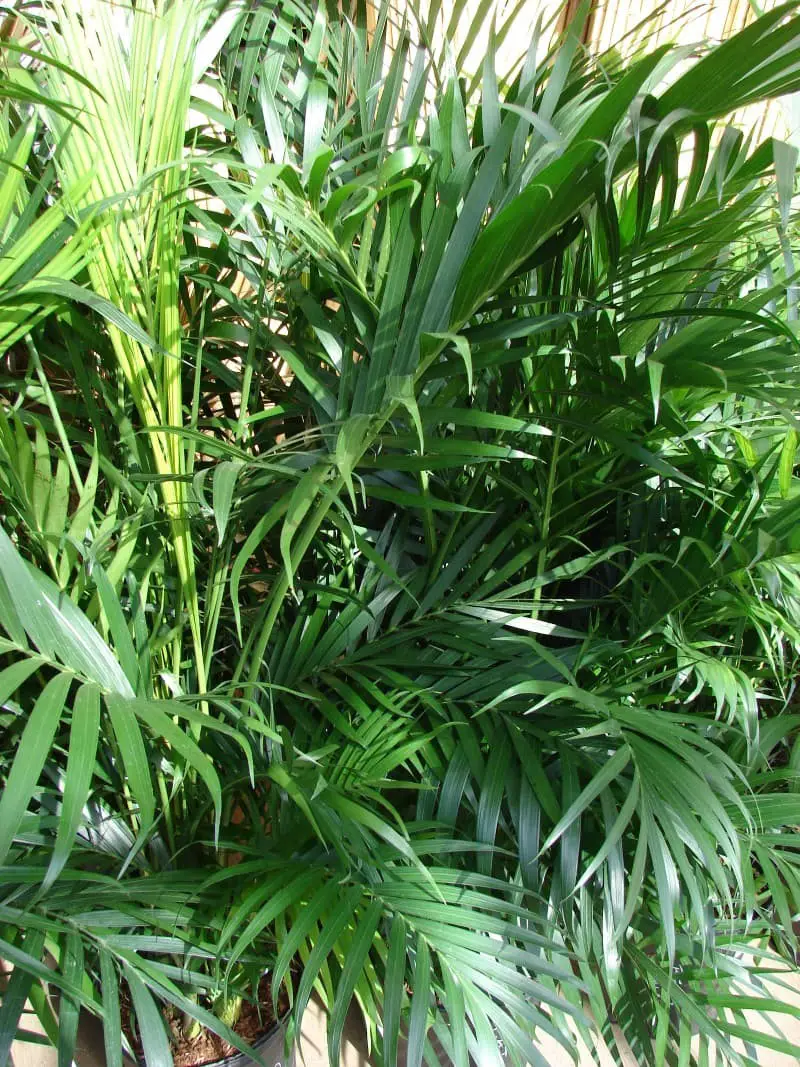
For those seeking a low-fuss palm that won’t outgrow its space, the Cat Palm is an excellent choice! Native to Mexico, this plant reaches a manageable height of approximately six feet. Its striking dark green leaves are a bonus, and it flourishes in bright, indirect sunlight. Furthermore, the Cat Palm is one of the most budget-friendly palms available, making it an attractive option for gardeners on a tight budget.
This compact palm is ideal for small spaces or containers, provided good drainage is ensured and regular watering is practiced. With proper care and attention, your Cat Palm will thrive for years to come, becoming a stunning addition to any indoor or outdoor setting.
Christmas Palm or Manila palm (Adonidia merrillii).
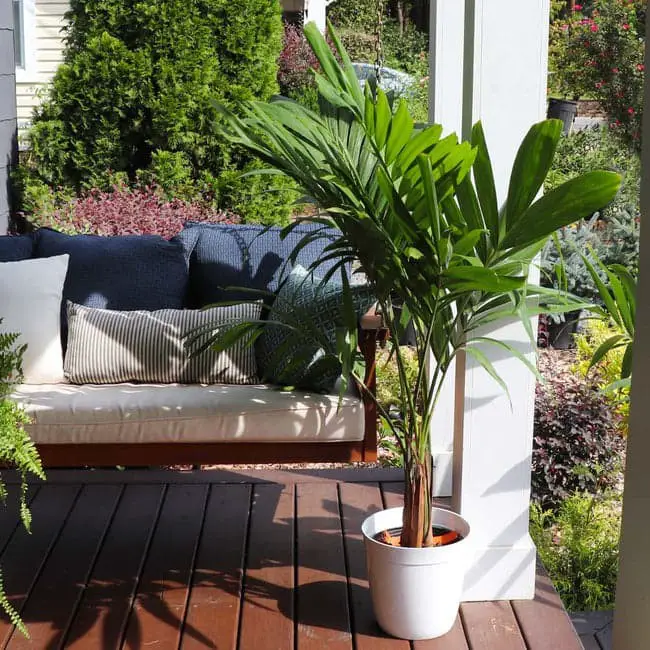
The Christmas palm is a charming, small to medium-sized tree that boasts an impressive height range of 20-40 feet. Its slender trunk features smooth, greenish-brown bark, while its pinnate leaves are a stunning combination of dark green above and silver-green below. Native to the Philippines, this tropical palm is widely cultivated due to its popularity in both ornamental and cut flower applications.
While it may be a relatively slow-growing species, the Christmas palm is surprisingly adaptable, thriving under a variety of conditions, including full sun, partial shade, and even complete shade. Once established, it’s quite drought-tolerant and requires minimal maintenance, making it an attractive choice for many gardeners.
Interestingly, this palm can be propagated through seed or by dividing the suckers that form at its base, offering multiple options for those looking to share its beauty with others.
Coontie Palm (Zamia floridana).
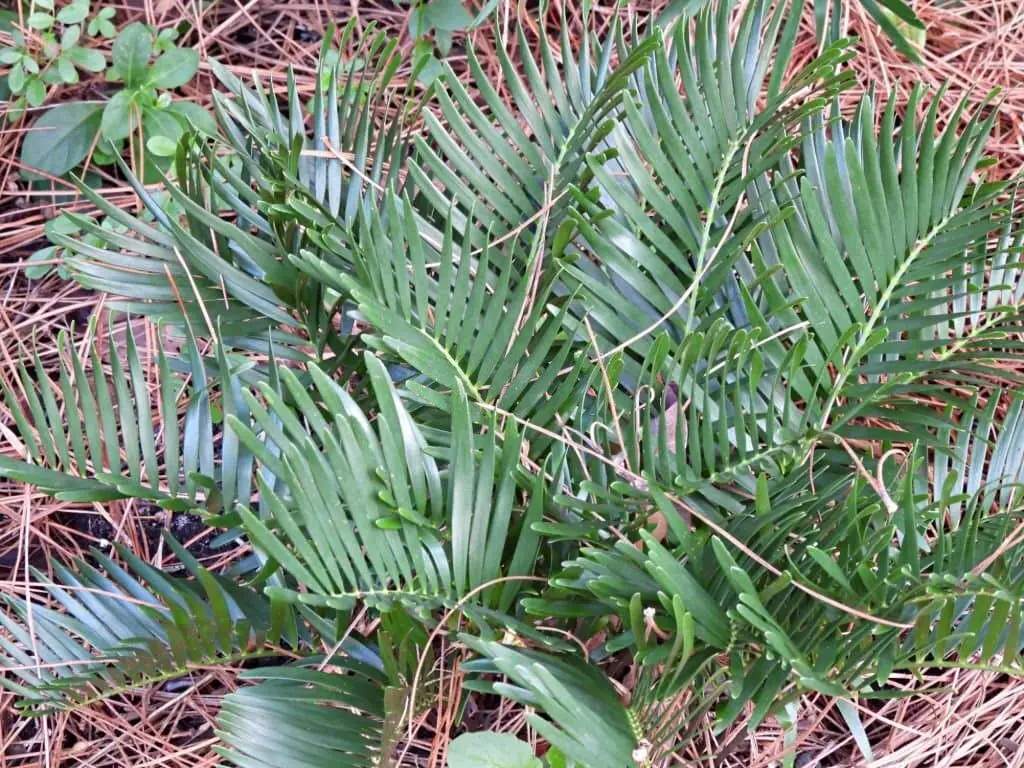
The Coontie Palm is an exceptional option for compact outdoor spaces, as it grows steadily up to 15 feet tall with a spread of approximately 12 feet. Its slow growth rate makes it suitable for small yards or gardens, allowing for easy maintenance and minimal space requirements.
One of the palm’s notable features is its remarkable drought tolerance, making it an excellent choice for coastal areas where salt spray can be prevalent.
Additionally, it can thrive in full sun but also tolerate some shade, providing flexibility in terms of placement.
The Coontie Palm’s hardiness spans zones nine through eleven, making it a viable option for gardeners within these regions. As an evergreen, its fronds can reach up to six feet in length, offering year-round foliage.
A notable aspect of the palm is its floral production, yielding small, yellowish-brown blooms that give way to black berries.
While the berries are toxic to humans, they serve as a vital food source for the Florida Scrub Jay, highlighting the importance of native species in ecosystem balance.
Dwarf Majesty Palm (Ravenea hildebrandtii).
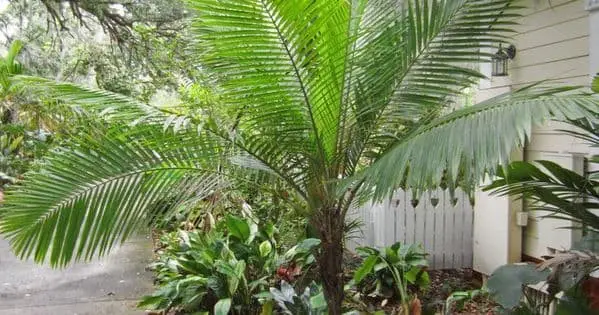
Ravenea palms, hailing from Madagascar, are a beloved species. As solitary palms, they don’t produce offsets or ‘pups’, so what you see is exactly what you get. Be cautious when handling the leaf stems, armed as they are with sharp spines. This palm grows steadily, reaching about 20 feet in height, and thrives in full sun. It’s remarkably adaptable, tolerating a wide range of soils as long as drainage is good.
Its cold tolerance is impressive, making it an ideal choice for landscaping in USDA hardiness zones 9b-11. At maturity, the Dwarf Majesty Palm stands tall at about 20 feet, its slender trunk wrapped in a brown fiber. The pinnate leaves stretch six feet long, with narrow, lanceolate leaflets that provide a striking visual display. A unique characteristic of this palm is its dioecious nature – male and female flowers grow on separate plants.
Small yellowish-white blooms emerge from among the leaf axils on inflorescences. These are followed by black fruits, which ripen and fall to the ground, providing sustenance for birds and other animals that help with seed dispersal.
Dwarf Palmetto (Sabal minor).
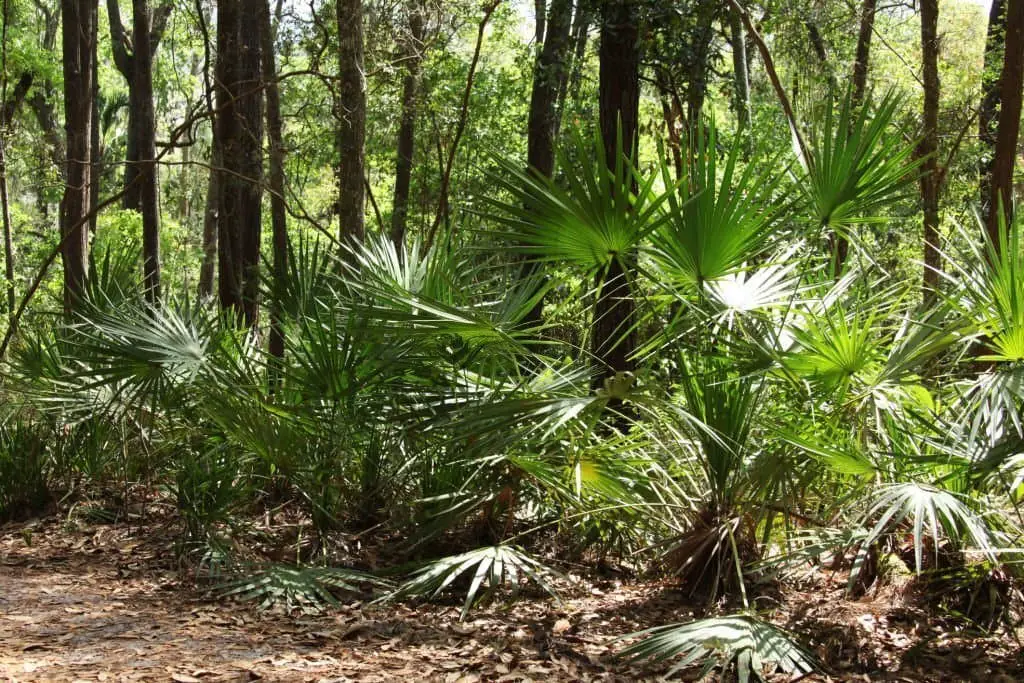
When it comes to adding a touch of tropical flair to a compact yard or landscape, the Dwarf Palmetto is an ideal choice. This hardy and adaptable palm can thrive in both sunny and shaded areas, effortlessly tolerating a broad range of soil types. Once established, it’s also surprisingly resilient to drought conditions, making it a low-maintenance option for busy gardeners.
As one of the most sought-after palms for landscaping in the southern United States, the Dwarf Palmetto has earned its reputation as a rugged yet elegant addition to any outdoor space. If you’re on the hunt for a diminutive palm that can withstand the elements and still look fabulous, this versatile variety is definitely worth considering.
Dwarf Sugar Palm (Arenga engleri).
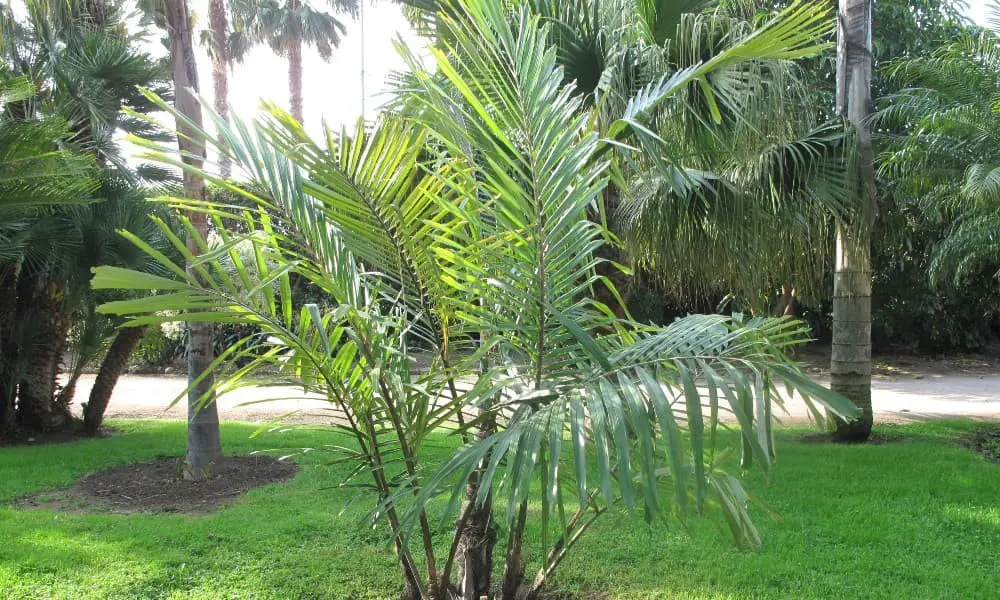
The Dwarf Sugar Palm (Arenga engleri) is an ideal choice for smaller spaces or indoor settings, offering a unique combination of elegance and versatility. Reaching heights of up to 20 feet in just a few years, this palm’s slender trunk and bright green, feathery leaves make it a stunning addition to poolside plantings or even interior design.
Native to Malaysia and Indonesia, the Dwarf Sugar Palm thrives in full sun to partial shade and exhibits remarkable hardiness, tolerating a range of soil types as long as they are well-drained. Once established, this palm is also surprisingly drought-tolerant, further solidifying its reputation as a low-maintenance yet high-reward addition to any landscape.
Florida Thatch Palm (Thrinax radiate).
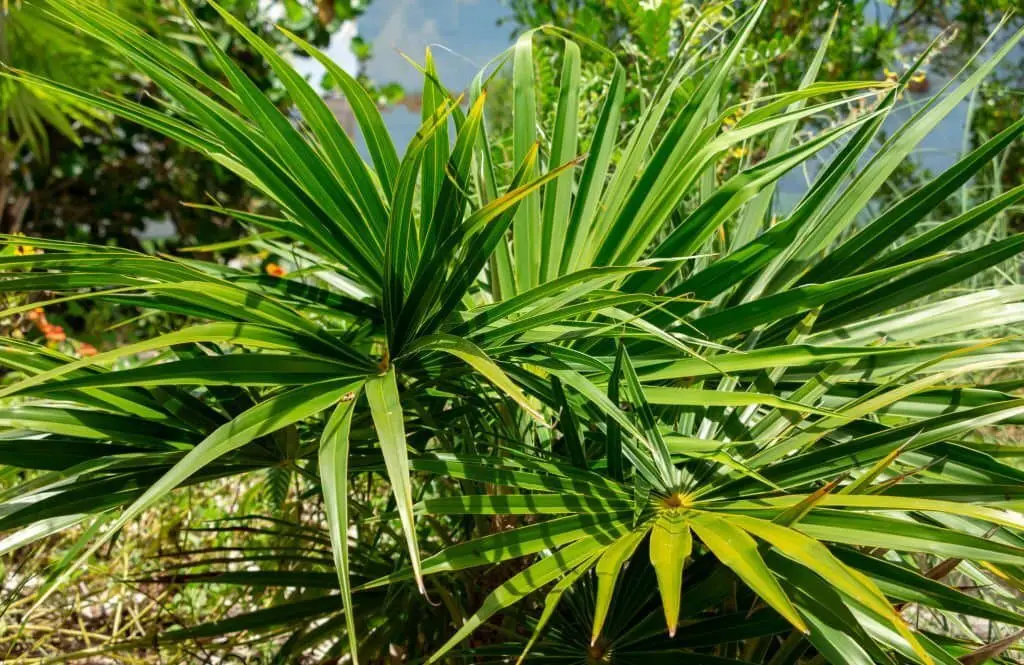
In the realm of palms, the Florida Thatch Palm stands out for its compact size and adaptability. Measuring around 15 feet tall, this slender-trunked palm boasts palmate leaves that thrive in full sun and moist, well-drained soil. Its native habitat stretches from Cuba to the Bahamas, but it has made itself at home in many parts of Florida.
A popular choice for landscaping, the Florida Thatch Palm excels as a specimen tree or in mass plantings, where its salt tolerance allows it to shine in coastal areas.
Mazari Palm (Nannorrhops ritchiana).
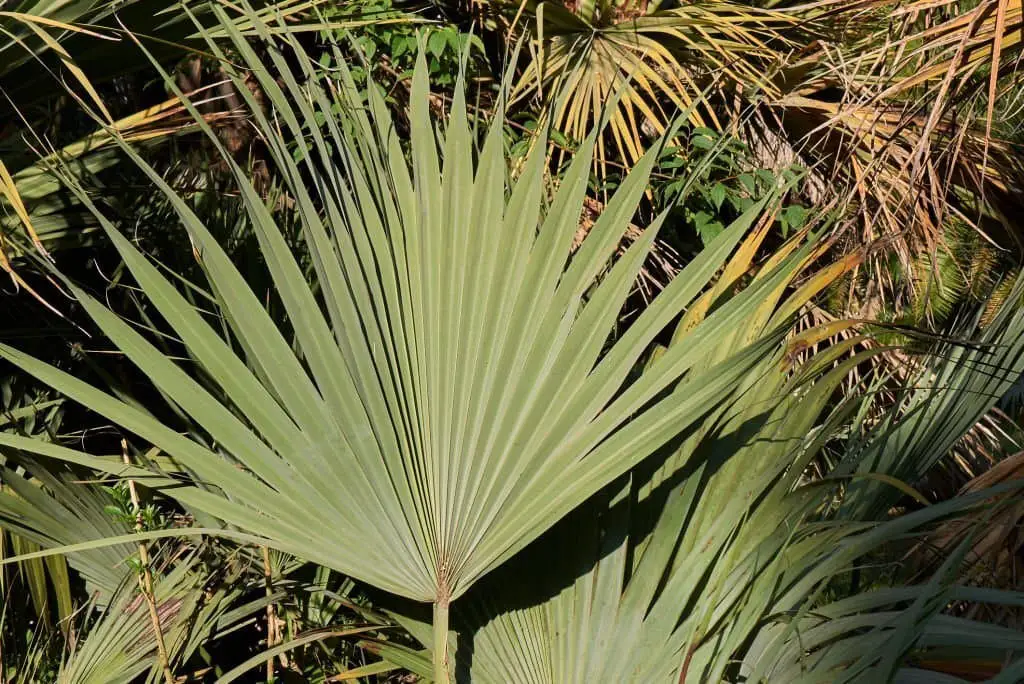
The Mazari Palm, native to the Middle East, boasts striking blue-green foliage that can reach heights of up to 15 feet tall, although it often thrives at smaller sizes. When it comes to lighting, this palm excels in full sun, and once established, it’s surprisingly drought-tolerant. Additionally, it exhibits impressive cold hardiness, capable of withstanding temperatures as low as 20 degrees Fahrenheit.
For those seeking a compact or dwarf palm tree option, the Mazari Palm is an excellent choice.
Mediterranean Dwarf Palm or European Fan Palm (Chamaerops humilis).
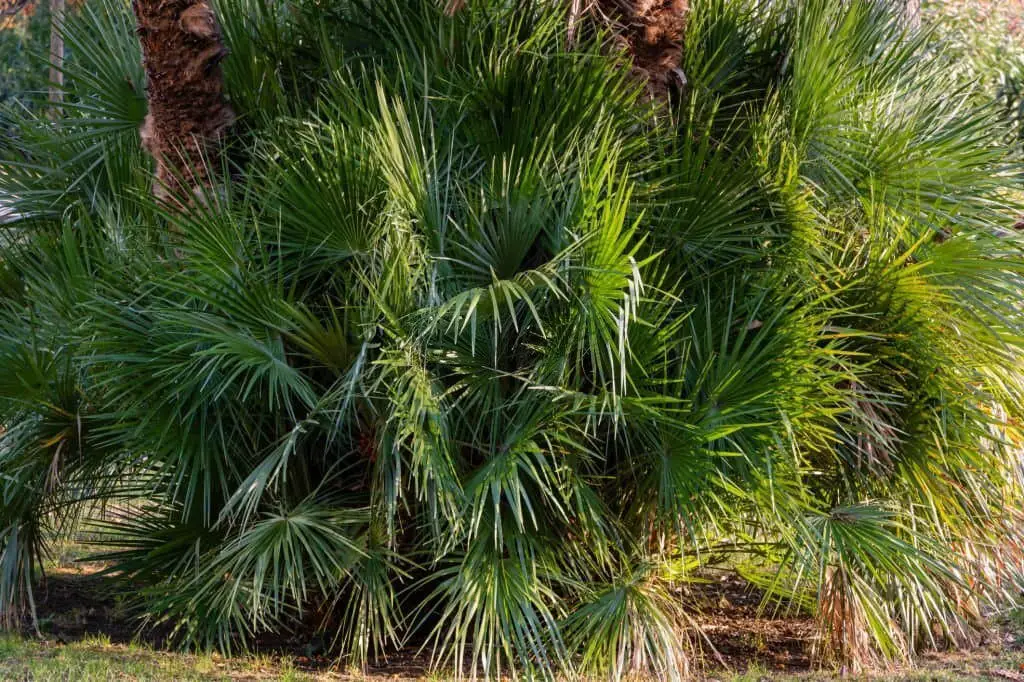
For those seeking a resilient and cold-hardy small or dwarf palm, look no further than this impressive species. Native to the mountainous regions of southern Europe, it has developed an extraordinary ability to withstand frigid temperatures, even as low as -15 degrees Celsius. The fan-shaped fronds of this palm can reach up to approximately one meter in length, providing a stunning visual display.
One of its most notable characteristics is its slow growth rate, which means it won’t quickly outgrow its surroundings.
Needle palm (Rhapidophyllum hystrix).
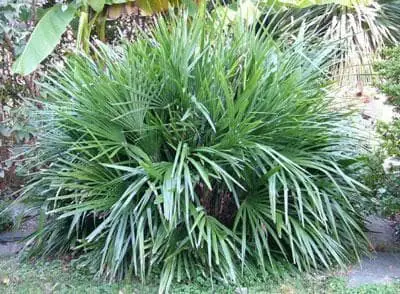
Located at the northernmost tip of where palm trees naturally thrive, you’ll find the southeastern United States playing host to this remarkable species. The northern needle palm stands tall at 15-20 feet, its medium-sized stature belied by the dramatic impact of its dark green leaves, adorned with sharp, serrated leaflets that give it its distinctive name.
As its common moniker suggests, this resilient palm is well-equipped to withstand harsh winter conditions, tolerating temperatures as low as -15 degrees Fahrenheit. Additionally, once established, it proves surprisingly drought-tolerant, making it a dependable choice for gardeners and landscapers alike.
Parlor Palm (Chamaedorea elegans).
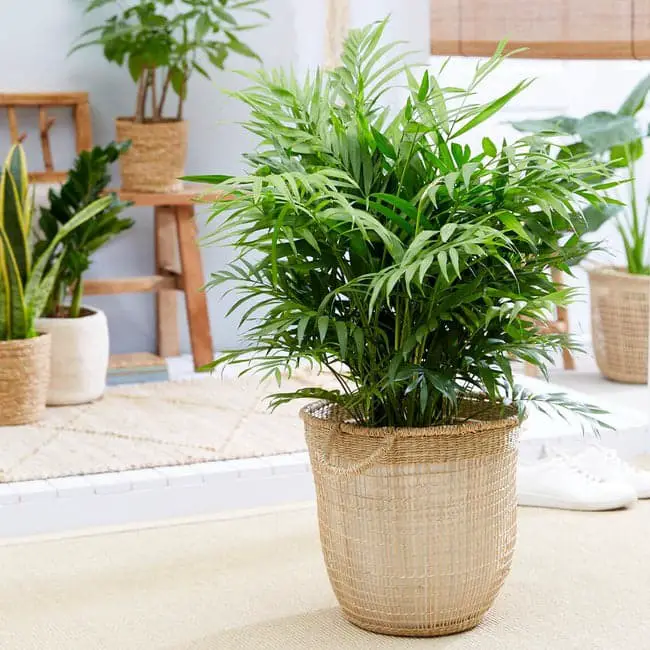
When it comes to finding a low-maintenance yet charming addition to your indoor space, the Parlor Palm is an excellent option. Reaching up to six feet tall when grown indoors, this palm is surprisingly compact for its stature, making it perfect for small spaces or those who prefer a more diminutive display. With a little TLC and regular pruning, you can keep it at a manageable size.
While bright, indirect light is ideal for optimal growth, the Parlor Palm is also surprisingly adaptable to lower light levels, providing flexibility in terms of placement within your home. To encourage healthy development, be sure to maintain even moisture levels and fertilize regularly during its active growing season.
Pindo Palm (Butia capitata).
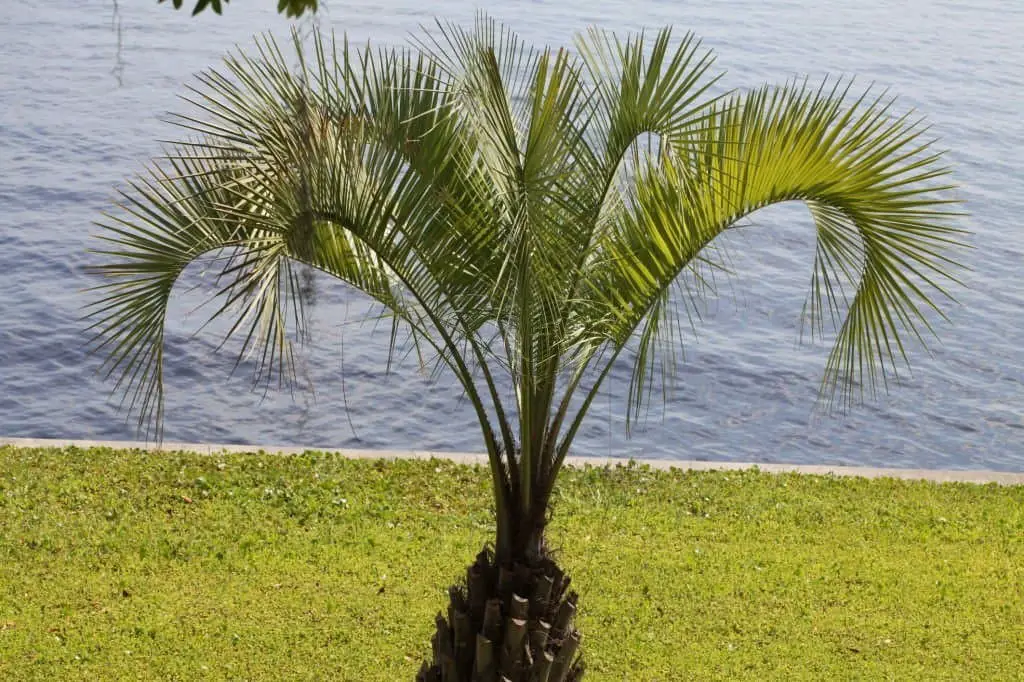
With its remarkable ability to thrive in cold temperatures, the Pindo Palm has earned a reputation as a hardy and adaptable species. Native to the southeastern United States, this versatile palm can be identified by its striking 20-foot stature and broad canopy of fronds, making it an ideal choice for small or compact landscapes. Moreover, the Pindo Palm’s fruit is highly prized for its jelly-making potential, earning it the nickname ‘Jelly Palm’ among enthusiasts.
Pygmy Date Palm (Phoenix roebelenii).
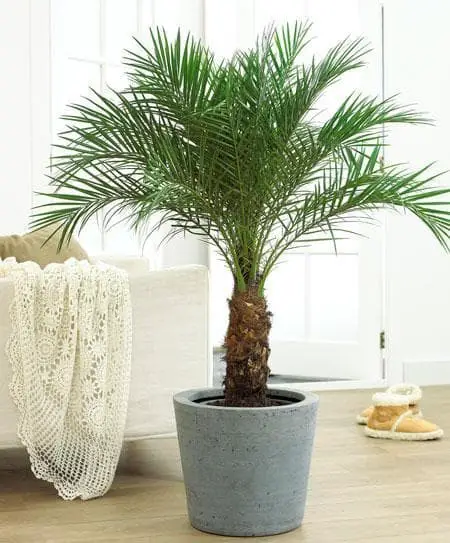
Looking for a miniature palm that still packs a visual punch? The Pygmy Date Palm is an excellent option. Reaching heights of around 15 feet, it boasts elegant, drooping fronds that add a touch of tropical charm to any space.
This palm thrives in full sun and well-drained soil, but also shows impressive resilience when it comes to water. It’s drought-tolerant once established, and can even handle short periods of flooding without batting an eye.
Native to southeastern Asia, the Pygmy Date Palm is often cultivated as a houseplant, offering a unique blend of beauty and practicality. While they may be harder to find in nurseries, the effort is well worth it for those seeking a statement piece that’s both compact and striking.
Sago Palm (Cycas revoluta).
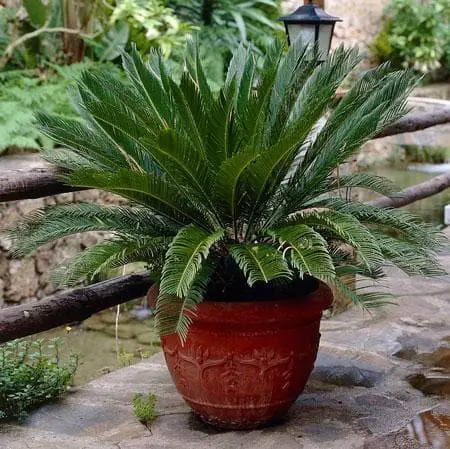
The sago palm, a compact to medium-sized plant, typically reaches heights of around 15 feet. Its slender trunk supports a crown of stiff, elongated leaves. Native to Japan and China, this ornamental favorite has been introduced to numerous regions worldwide. Beyond its aesthetic appeal, the sago palm also serves as a source of sago flour. A dioecious plant, sago palms are characterized by separate male and female specimens. Male plants produce pollen, while female plants yield ovules.
The pollination process unfolds when pollen from the male plant comes into contact with an ovule from the female plant. Subsequently, the ovule develops into a seed. Sago palms grow relatively slowly, requiring many years to reach full maturity. However, they are also remarkable for their longevity, with some specimens exceeding 100-year lifespans. Notably, these plants are straightforward to care for and don’t necessitate excessive maintenance.
As such, the sago palm is an excellent choice for those seeking a low-maintenance, long-lived palm tree.
Saw Palmetto (Sereona).
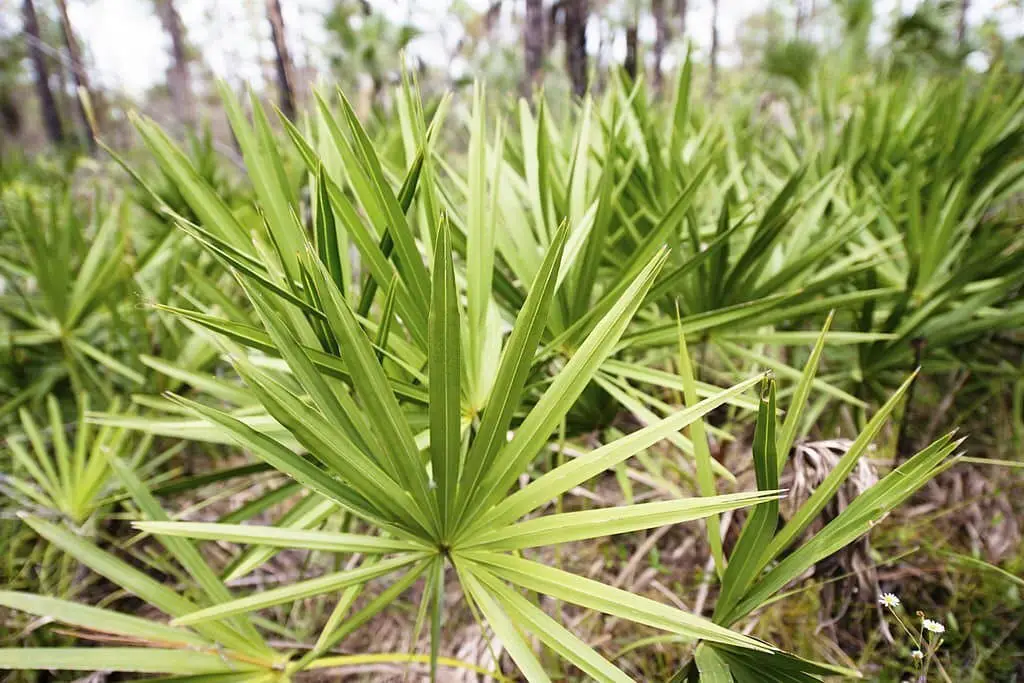
The Saw Palmetto boasts a slender trunk adorned with stunning green fronds that elegantly curve upwards. This versatile palm excels in small gardens or as a striking accent plant in larger landscapes. For those seeking a low-fuss, drought-resistant palm, the Saw Palmetto is an excellent option.
Short Bottle Palm (Hyophorbe lagenicaulis).
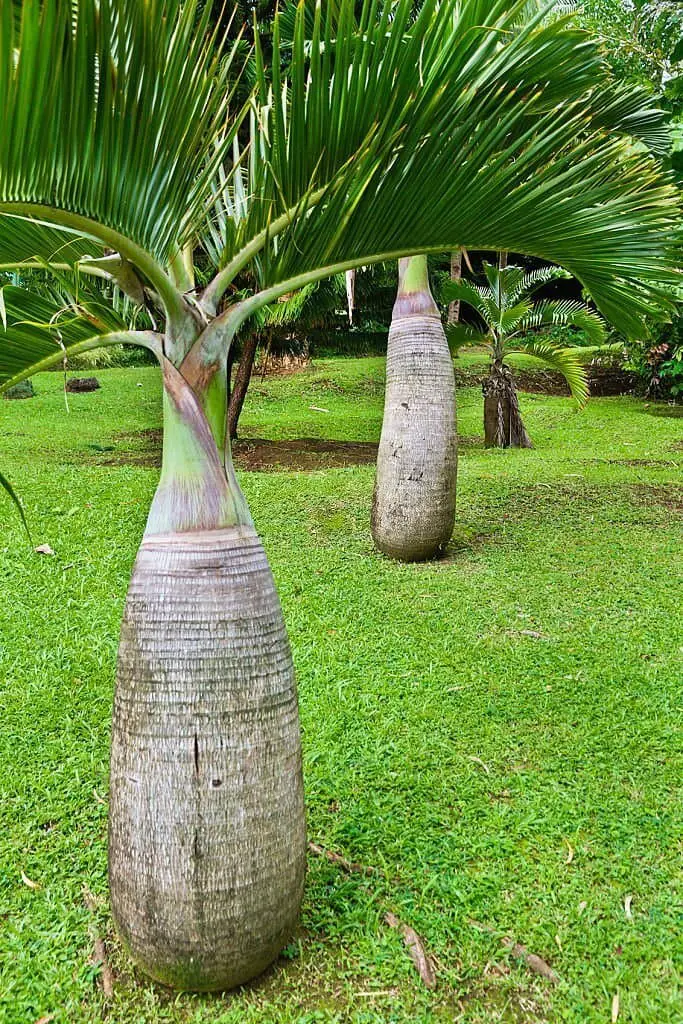
For those seeking a compact palm tree to bring some greenery into their indoor space, the Short Bottle Palm is an excellent choice. This slender-stemmed palm variety grows to around six feet in height, making it well-suited for smaller rooms or office spaces where vertical growth might be limited. Additionally, the Short Bottle Palm is relatively low-maintenance, requiring only occasional watering and gentle misting to keep its leaves looking their best.
Spindle Palm (Hyophorbe verschaffeltii).
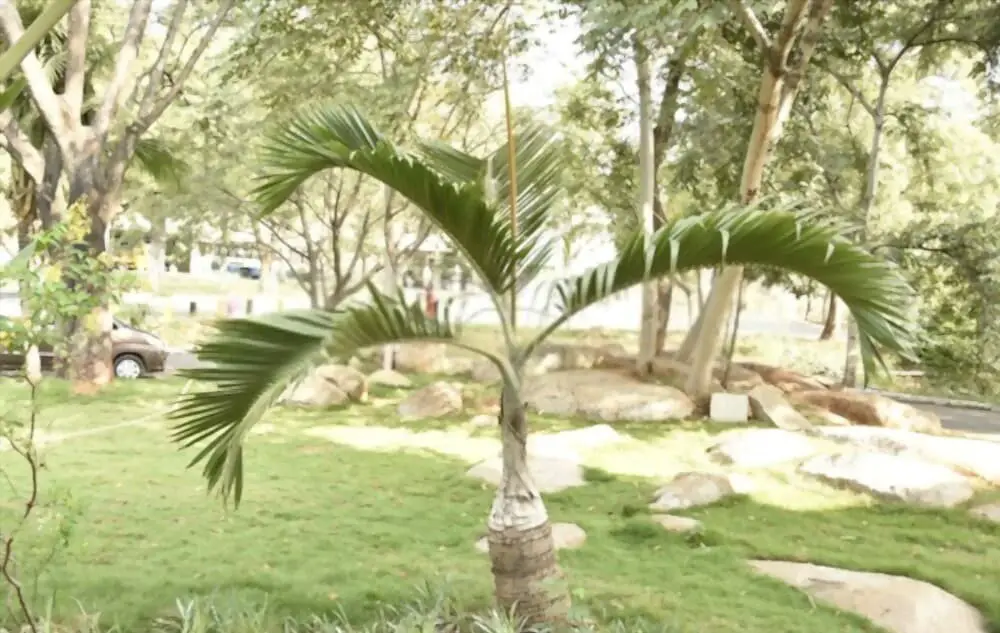
With its compact size, the Spindle Palm (up to 15 feet tall) boasts a unique charm. Its elongated leaves are adorned with spines along their margins, adding an extra layer of character to this striking palm. The white flowers, clustered at the leaf axils, and the black drupe fruit with a single seed only add to its appeal. Native to Madagascar, this ornamental plant thrives in gardens and parks, while also being used in landscaping and as a stylish houseplant.
Notably, the Spindle Palm exhibits remarkable resilience, tolerating drought and salt spray – making it an excellent choice for coastal areas. Additionally, its adaptability extends to container growth, perfect for patio or deck plants, where it can add a touch of tropical flair.
Triangle Palm Tree (Dypsis decaryi).
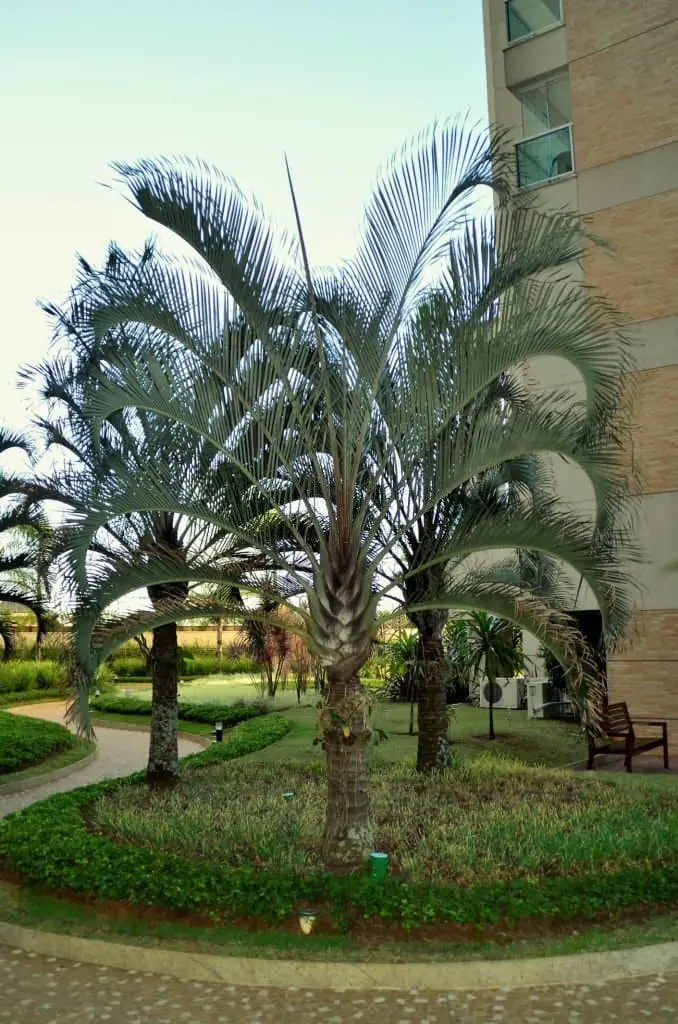
One of the most sought-after palms for indoor cultivation is the Triangle Palm. Characterized by its moderate growth rate, this species can reach heights of up to six feet, rendering it an excellent choice for compact spaces. Its triangular leaves boast a striking silvery-green hue, while its natural habitat on Madagascar suggests that it thrives in warm and humid environments.
Windmill Palm (Trachycarpus fortune).
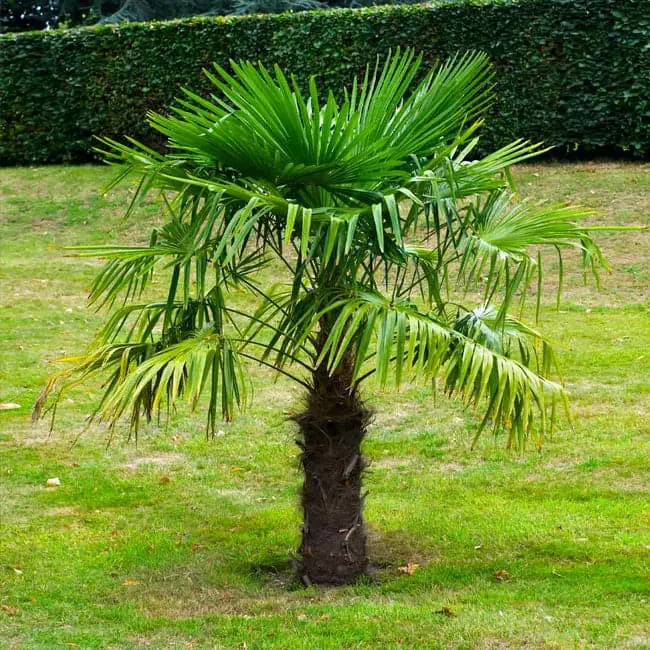
For those seeking a resilient palm that can thrive in chilly conditions, this option is an excellent choice. Hardiness zones 7-11 make it suitable for many climates. Additionally, windmill palms are ideal for those looking to add a touch of tropical flair without sacrificing space. Reaching heights of under 20 feet, they’re perfect for small yards or patio gardens. With these characteristics in mind, consider this palm as a top contender.
What is the name of the dwarf palm tree?
Phoenix roebelenii, also known as the pygmy date palm, miniature date palm, and Robellini Palm, is a species of palm tree that hails from Southeast Asia. This diminutive palm grows to be around 15 feet tall, with a trunk diameter of approximately 12 inches. Its leaves are pinnate, or feather-like, measuring about 18 inches in length. The flowers of the dwarf palm tree bloom in clusters and have a yellowish-white hue.
The fruit, a type of drupe, measures roughly an inch in diameter and features a hard seed encased in fleshy material. Due to its ornamental value, the dwarf palm tree is widely cultivated and often used as a houseplant or in landscaping.
How tall do dwarf palm trees get?
While dwarf palm trees are often prized for their compact size, it’s interesting to explore just how tall these miniature palms can reach. On average, most varieties of dwarf palm trees tend to grow to around 12 feet in height, with some exceptional examples reaching as high as 20 feet. However, the champion among them is undoubtedly the Canary Island Date Palm, which can astonishingly stretch up to an impressive 40 feet tall.
Conclusion
When it comes to selecting the perfect small or dwarf palm tree for your landscape, it’s all about finding the one that perfectly captures the aesthetic you’re aiming for. While there isn’t a single ‘ideal’ option, these five exceptional varieties are sure to elevate the beauty and value of your home. By doing your due diligence and researching which variety best fits your needs, you’ll be able to enjoy the unique charm and tropical flair that palm trees bring to any yard.
Related Posts
Discovering the vast array of plant varieties available online has never been easier. From the iconic apple tree to the evergreen’s year-round vibrancy, there’s a world of possibilities waiting for you. Not only can you find inspiration for your own garden, but you can also explore the rewarding career path of becoming an arborist – dedicated professionals who care for and maintain trees in our communities. Beyond their aesthetic appeal, trees play a significant role in enhancing property value.
Whether it’s pruning to create a manicured landscape or removing unwanted growth, understanding the impact of trees on your home’s curb appeal is crucial. But did you know that certain plants, like the lady palm (Rhapis excelsa), require special care and attention? Or how about growing organic blueberry plants in your own backyard? With the right guidance, you can unlock the secrets to nurturing these beautiful additions to your outdoor space.






